Halo halo! Happy Monday! Fabi here, writing to you from Tangerang 🇮🇩 and Kaohsiung 🇹🇼.
If this is the first time you’re here - welcome to Kepayang! This is where I write essays on food, culture, and sustainability every two weeks (that’s the aim). But other than that, Kepayang is also a vibrant community too. We’re a bunch of food enthusiasts, creatives, and geeks who know how to have fun.
Today’s newsletter is a personal story of mine about why I think aeroplane food doesn’t deserve all the hate. Some people even go to the length of saying they’d rather be hungry than eat aeroplane food. Weird. I hope you’re not that person, and if you do, give me to me your food please!!!
If you Google it, you’ll see how much aeroplane food has improved over the years. But today, I’d like to get personal. Flying has always felt special to me, especially the occasion and the destination. And food is part of the whole experience. Hope you enjoy the read!
Kepayang is free for now, so any engagements mean so much to support the platform’s growth. You can subscribe to get the newsletter sent directly to your email, like, comment, and share if you resonate with what I write.
Alternatively, you can buy me a coffee through my PayPal here: https://paypal.me/chalafabia - or if you’re based in Indonesia, you can send your donation through QRIS here (under the name Tamanan). Any amounts are welcomed and will directly contribute to sustaining this platform to cover expenses related to operations, research, writing, and marketing. ☕️
Aeroplane food often gets a bad reputation. It’s commonly seen as unappetising, bland, and served in less-than-ideal conditions. While some of these may be true, it’s important to consider that you are flying at 9,000 meters above the ground. At this height, your taste buds, especially those detecting sweetness and saltiness, can lose up to one-third of their sensitivity. Scientifically speaking, food will taste different in the air.
However, it would be wrong to assume that airlines are unaware of this or are doing nothing to improve your in-flight dining experience. In fact, many airlines go to great lengths to make aeroplane food more enjoyable. Caterers often adjust their recipes, adding more sugar and salt. They experiment with different methods for preparing and reheating meals onboard. Some, have even identified specific ingredients, such as cardamom, tomatoes, and curry powder, that retain their taste and aroma even at high altitudes (BBC, 2015).
It’s cool to see how airlines are trying to make their food better. But let me share with you a personal story of mine that shaped how I feel about aeroplane food.
During one of our community hangouts last year, someone shared a story about a memorable dish from their childhood — a spinach omelette. What made this dish special wasn’t because it uses a fancy type of egg or spinach that is grown in a certain way. Instead, it was the fact that their father always brought this omelette home every time he came home from his job on the aeroplane. They shared that they would always wait for their father to come home, and the omelette became a symbol of warmth and togetherness in their family.
I didn’t remember much about how they described the taste of the spinach omelette. But it’s an omelette coming from an aeroplane. It probably wasn’t the best.
As a fan of aeroplane food, I confidently asked the group, “Who else here loves aeroplane food as much as I do?”. To my surprise, it took a painfully long five seconds for just two people to hesitantly raise their hands. Those were the longest five seconds of my life.
So, to keep the silence from getting louder, I doubled down: “Oh, come on, aeroplane food is not that bad!” But around the same time, someone jumped in, saying, “I’m not a fan of aeroplane food.” “It doesn’t look appetising, and sometimes it doesn’t taste like much” they added. “I knew someone would say this”, I said to myself.
I can’t deny that I somewhat agree, especially when I think back to my childhood experiences.
When I was a kid, my family mostly took short-haul flights, usually between provinces to Jawa Timur or Bali or neighbouring countries like Malaysia or Singapore. This meant we often flew with low-cost carriers (LCCs) that didn’t serve meals. Even if they did, food was usually an add-on, limited in choice, and honestly unnecessary for a quick two-hour flight.
For longer flights, my family also likes to fly with LCCs, but had a different strategy: eat anywhere but on the plane. Whether it was before going to the airport or at one of the airport restaurants, we’d make sure to have a proper meal before boarding. I remember one of the first long-haul flights I took regularly was when I studied in Australia. We’d fly with AirAsia, which had this absurd route that went through Kuala Lumpur before heading to Sydney. The total flight time was about nine hours, but door-to-door, it stretched to over 12. And every single time, we found ways to not eat on the plane.
For us, I think this habit is more financially-motivated. Frugal, if I do say so myself. I have to agree, that getting aeroplane food, especially when it’s an add-on, is not worth the penny. Airlines can charge a premium for food, even if it’s not the bestest quality. They know we don’t have many options. You’re stuck in the air, and it’s either that chicken satay with questionable peanut butter dressing or nothing.
So, yeah, I get it. If I have to pay extra for an aeroplane meal, I’d much rather eat anywhere but on the plane.
But once I got my first job and started making my own money, I could afford, or at least finally be willing to pay, for full-service flights. The first flight I paid for using my own money was Garuda Indonesia, flying from Sydney to Jakarta. It felt like a splurge — not just because the ticket was several times the price of AirAsia, but because of the amount of food they gave me.
Aside from the main course, there were bread, salads, desserts, free-flowing juice, water, soft drinks, and even wine. Yes, the sparkling kind. But that wasn’t what surprised me. Instead, it was the mango ice cream they served after the meal.
That flight was a game-changer for me. I may not remember every single thing I ate, but I do remember the joy of spending a little extra to treat myself. Plus, since this was the flight I always took when going back to Indonesia, the thought of coming home added a whole lot of warmth and excitement to the whole experience.
Maybe that’s why I enjoyed aeroplane food so much — not because of how it tasted, but because I was excited about going somewhere meaningful, especially home.
While I can’t recall much about Garuda Indonesia’s food that I ate before, I’m actually writing this essay in a boarding room, waiting for my upcoming flight from Jakarta to Taipei! So let me bring you along to what I had during this overnight flight.
Aeroplane food, even on a full-service flight, can be tricky when you have dietary restrictions. I was a pescatarian for three years starting in 2021. This means that if I don’t make any special requests, there will be the risk of me facing the illusion of choice between the two things I don’t eat: chicken or beef.
Side thought: Do you think it’s funny how some flight attendants don’t even bother saying the full menu descriptions? Like whether it’s "chicken curry with rice" or "black pepper beef with stir-fried noodles’, what I hear is always the three words: "chicken or beef". I think for some people these are the most important part when deciding what food they wanna get.
Since I’m going full vegetarian this year, I always make sure that I pre-book my meal and let the airline know I don’t eat meat. Doing this ensures I’ll have a meal that I can actually eat. And on top of that, it’s not just a meal. It’s a special meal. It’s like having a secret meal that doesn’t exist on the menu. And more often than not, it will be given before the general trolley service starts. Talk about being a special person!

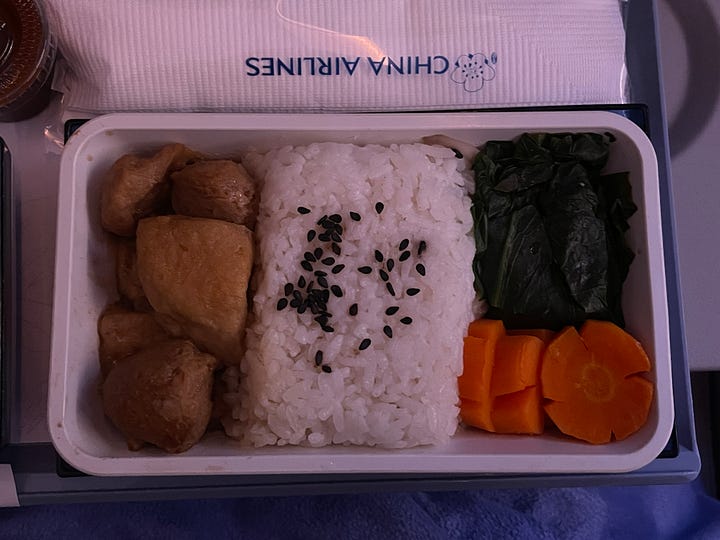
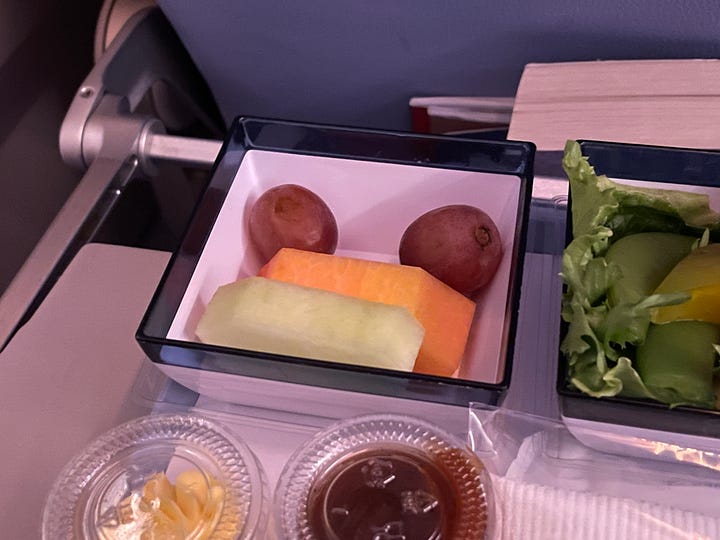
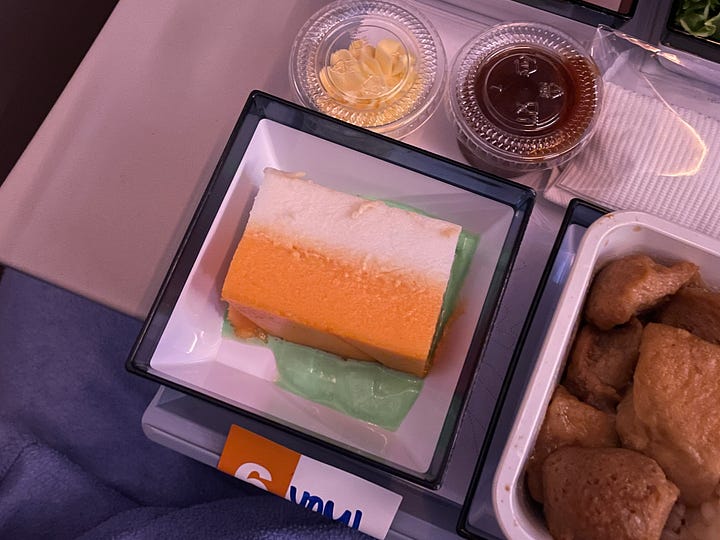
I like to eat my food in a certain order, and here is how:
🥗 First thing first, salad. I honestly thought that this salad was a Mediterranean salad since the first thing that I saw was a roasted yellow capsicum, black olives, and cut cucumber. But somehow they also put shiitake mushroom, not to mention, a balsamic vinegar dressing. I’d like to call this a Mr. Worldwide salad. They’re super fresh and crunchy, and I appreciate how they charred the capsicum to make it extra fragrant.
🍚 My favourite part of the dinner: rice. Nothing special about the rice, it’s just steamed white rice. But it was served with the most savoury mock soymeat I’ve ever tasted. If you have made your own mock meat, you would know that it tasted like wet cardboard. This, on the other hand, was marinated properly in an ambiguous sweet and savoury Asian sauce — like something you would get in a Singaporean Hainanese chicken, but sweeter. Garlic, soy sauce, ginger. I can taste everything.
🍇 Cut fruits were nice and fridge cold (I hate room temperature fruit), and so was the sweet potato pudding. I think they’re trying to achieve the iconic Kue Talam — an Indonesian classic steamed cake made of sweet potato and coconut. It was served with a brat-coded sauce that tasted like pandan, the essence one.
Overall, it’s a very pleasant dinner with nutritionally balanced nutrition. Can’t ask for a better meal this time. Except that I should’ve gone for seconds on that sparkling passionfruit tea at the end.
Aeroplane food can be hit or miss. There are a lot of factors at play. The fact that we lose some of our ability to smell and taste is enough to explain why aeroplane food tastes different. And of course, getting a meal that doesn’t match your taste can make the experience less exciting. I, too, have had some flop meals — dishes that are completely different from what I usually enjoy.
But as someone who rarely gets to fly and only does so for special occasions, just being on a plane is a special experience that I always look forward to. The thought of going somewhere exciting, treating myself not only to a nice meal but also to something nutritionally balanced, feels like such a treat. That’s what I like about aeroplane food.
I’ll see you in two weeks for another post about what I ate in Taiwan. Let me know if there’s something specific you’d like to hear!
Other contents that I made recently:
🇹🇷 Read on how I learned about Turkiye’s inflation through food: here.
💥 Read on the smart Indonesian crunch culture: here.
🚦 Read on the problem behind street food vendors relocation: here.
🤔 Read on how Indonesians please others when it comes to food: here.
🎪 Read on the wacky way we Indonesians name our food: here.
If you like today’s newsletter, please like and share it with your friends! Comment down below your thoughts and let me know if you have any other topics you want me to discuss. Until then, I’ll see you in two weeks!
Follow me everywhere:
TikTok: @berusahavegan
Kepayang’s Instagram: @readkepayang
Instagram: @menggemaskan
LinkedIn: Chalafabia Haris
Work with me: readkepayang@gmail.com





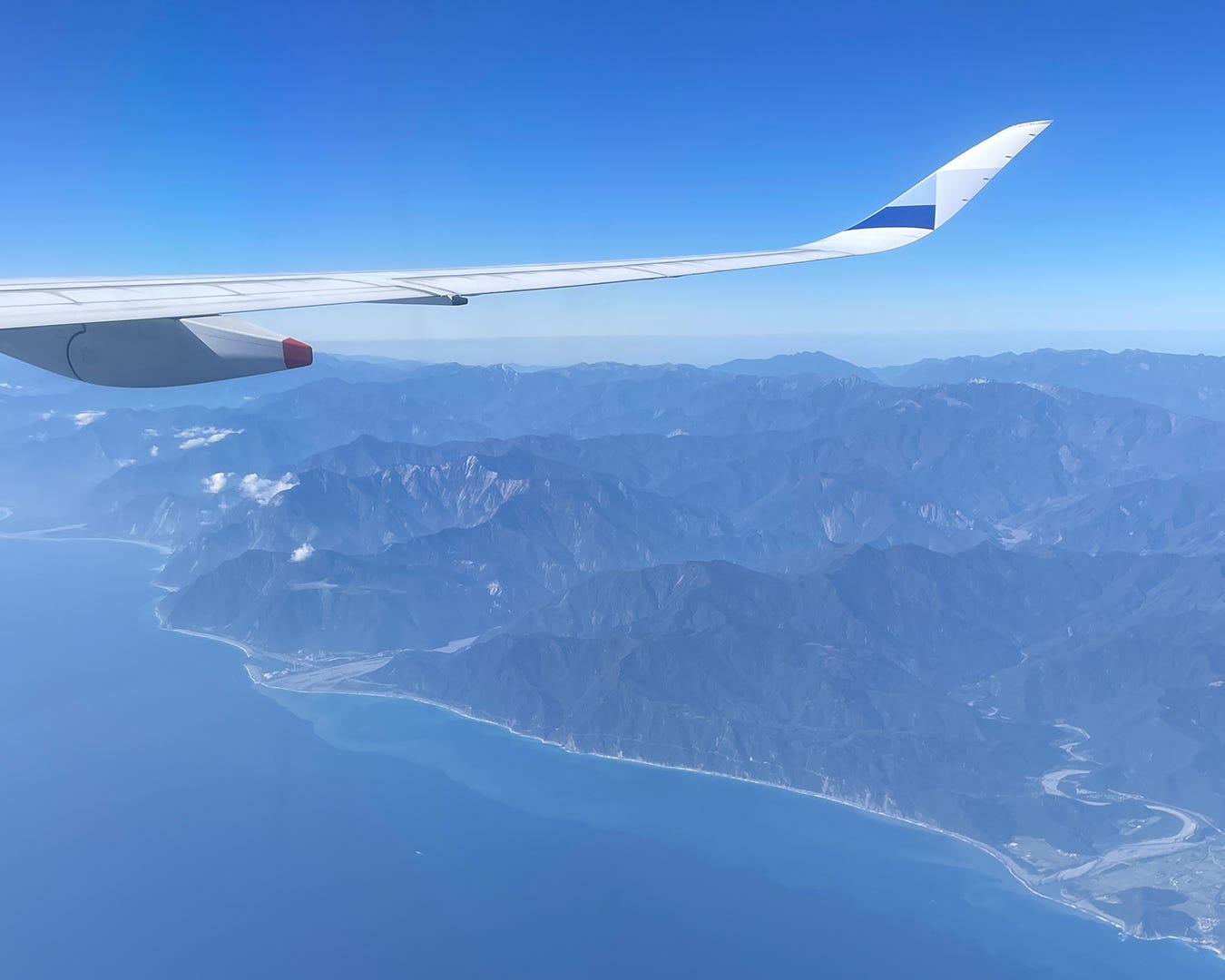
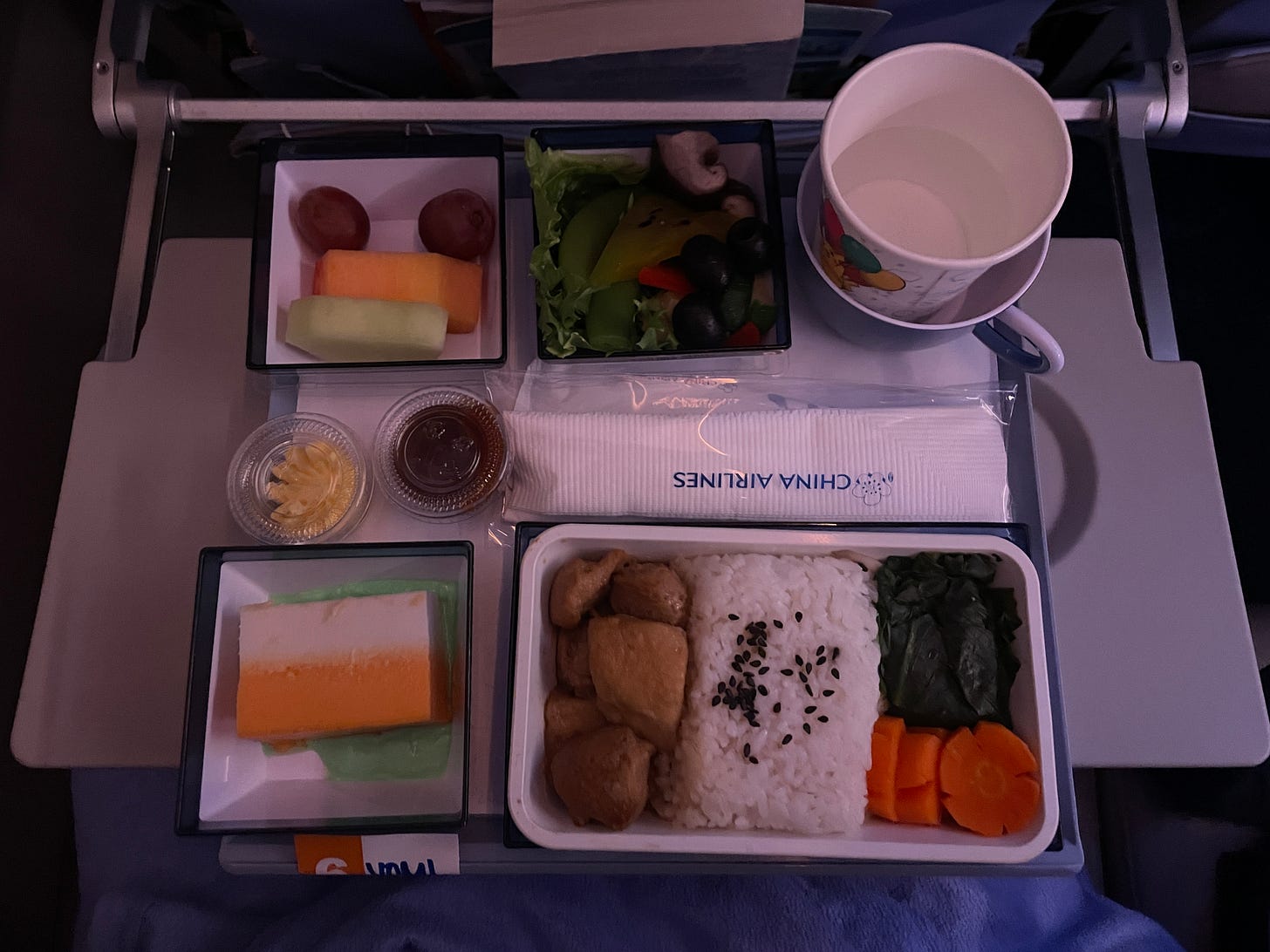
I think it depends on the airline too. I agree that mostly international/long-haul flights offer more delicious options. I did have some good meals in the air while watching a movie or just lying down with a blanket on. I like that even airplane food can be a part of someone's (and your) core memories. Can't wait to read the stories from Taiwan.
Unpopular opinion but I also like airplane food !!! I always told this to people and they often disagree 😂 emang hit or miss tp somehow seru kyk porsi nya mini2 tp kenyang juga trs makannya sambil nonton TV sambil pake selimut. Gatau kenapa tp pewe 😂